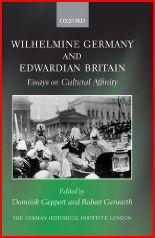
Editor-in-chief Trevor Harris
Book Review Editor Molly O'Brien Castro
![]()
Dominik Geppert and Robert Gerwarth, eds., Wilhelmine Germany and Edwardian Britain: Essays on Cultural Affinity (German Historical Institute London, Oxford University Press, 2008). UK £65, 91€, 464 pages, ISBN 13: 978-0-19-955828-5–Trevor Harris, Université François Rabelais, Tours.
The "cultural affinity"referred to in the title, taken in its widest sense, is a fascinating tangled web, the threads of which are explored in considerable detail through the eighteen contributions to this handsomely presented volume. The master narrative being countered here is that of the rapid deterioration of Anglo-German relations during the period scrutinised (principally the 1880s to the Great War, but reaching back towards the 1860s and forward to the 1930s on a number of occasions). The main objective is to challenge that perspective–which has tended to become a preconception–and re(in)state the complexities of Anglo-German relations, “the myriad entanglements and transfers” [3] between the two countries, by working carefully through a wide range of transnational “cultural” connections, contacts and links.
Rather than the neat parallel lines traced by some precise, pseudo-mechanical advance, however, the nature of that cultural exchange is necessarily more organic, tracing lines which often intersect, overlap and twist around each other. Further, the co-existence of fascination and anxiety in the face of modernity is one of the defining characteristics of the European fin-de-siècle and Anglo-German relations, logically enough, bear the imprint of that paradox: as David Blackbourn puts it, “[British] respect fed suspicion about German intentions” [35]. The same antithetical urges lead John C. G. Röhl to underline “how difficult it is to disentangle the contradictory strands that comprised William’s attitude to England” [50]. It would clearly be over-simplistic to affirm that Wilhelmine Germany felt some straightforward cultural/political inferiority complex in respect of late-Victorian/Edwardian Britain. Yet, expressions of Teutonic solidarity could not, for example, mask Edward’s mistrust of the Kaiser, or the latter’s inconsistent, even unpredictable behaviour towards England.
Indeed, imitation–if one is to believe the old saying–is the sincerest form of flattery. But any exchange is perhaps already a covert or nascent form of rivalry. The temptation to indulge in a form of national one-upmanship is ever-present and Anglo-German exchanges between 1880 and 1914 are no exception. A number of the essays place the accent on the numerous “transnational” ambiguities of Anglo-German relations. Most clearly this is the case with Thomas Weber’s essay [249-69] on Anglo-German student encounters, the Anglo-Saxon race solidarity and the “cosmopolitan nationalism” which Weber explores proving unable to stave off the threat of war. Elsewhere in the book, whether it is parliamentary politics and electioneering–addressed within a tight time frame (1909-11) by Frank Lorenz Müller–or through the relationship between Empire and popular culture–a much broader issue which John Mackenzie takes on–the “Anglo-German [imperial] schizophrenia” [95] is always there: even the pomp of imperial exhibitions can surely be read as an affirmation of national weakness, so much whistling to keep up one’s spirits. Matthew Jefferies, writing on cultural transfer in architecture, approaches the question via “identifiable individuals” [332], rather than groups or classes, and underlines the existence of a set of transnational architectural ideals through which Nikolaus Pevsner, and others, worked to promote now a vernacular modernism, now a “democratic” reconciliation of (industrial) work and architecture. Whether all this was “picturesque” in essence or “fundamentalist”, it was clearly Anglo-German. The German reaction to much publicised colonial scandals (looked at by Frank Bösch) also shows a distinct tendency for one country to emulate the other, while at the same time adapting legislation to the local context: the “cultural transfer” even seems, as often as not, to have been more of a cultural rejection, as German legislators and lawyers attempted to distance themselves from Britain and carve out a distinct (colonial) identity for Germany in this regard. Jean H. Quataert (on women’s movements) is also writing in mainly transnational mode, though she does wonder whether such a perspective differs significantly from “the more standard approaches of comparative history” [173]–an “unresolved” [414] theoretical debate which is woven into (entangled within?) the entire volume and addressed directly by Jan Rüger in the last contribution to the book. To the extent that she teases out different contacts “which partly helped to reconfigure national politics” in both countries [183], Quataert appears to answer her own question in the affirmative, pointing out how, for example, a transnational movement such as the opposition to slavery helped to launch women’s movement in several different countries.
By contrast, Geoff Eley (writing on gender) and Jose Harris (on law and civil society) both approach their task in a more candidly comparative mode: in order to weigh up “aspects of national divergence” and particularly the “distinctive trajectories of liberalism since the 1860s” [Eley, 143]; or, a contrario, to emphasize similarities between legal systems and traditions in the two countries, similarities onto which divergences were artificially grafted, Jose Harris argues, by the wartime need to put the enemy at a convenient distance. Sven Oliver Müller, taking this approach a stage further, concludes that the “musical clash of civilisations” [305] which he documents is based on the deliberate manufacture of otherness, since “people have to create differences in order to be influenced by them” [328]. Dominik Geppert, investigating “lowbrow literature”–in practice, the popular press–weighs up the extent to which it is possible to see how the press, particularly in Britain, was instrumentalised and produced a discourse or “public opinion” which raised international tensions and effectively cornered politicians and diplomats. In practice, however, Geppert shows this to be an oversimplification, the reality being far more ambivalent–whether in Britain or Germany.
Yet
there do seem to have been real, fundamental differences between English
and German music, for example, in the early years of the twentieth
century. Sabine Freitag’s enquiry into crime, and the anxiety
generated by crime on either side of the North Sea, also shows that
significant differences existed within the judicial system perhaps
because of, rather than in spite of, the limited intellectual exchange
which Freitag sees at work in this area. Her discussion of the uses
of science is particularly illuminating to the extent that she demonstrates
how the criterion of “incorrigibility” [226-29] was extensively
exploited in Germany but not used in Britain, positing a clear emerging
difference in dominant attitudes towards biological determinism. “Otherness”,
here, would appear to be rather more than a mere construct. Oliver
Grant, too, looking at the development of university education in
Britain and Germany, uncovers evidence of numerous links or affinities,
but also shows how the German system was centralised and highly competitive,
while the British system relied heavily on a much more ad hoc, flexible
approach, typified by part-time and evening courses, and on localism
(a point also made in relation to popular sport by Christiane Eisenberg
[398-99], the German approach underlining national prestige and service
to the State). And since differences did exist, a creative synthesis
or syncretism (of English prose and German passion?) was a meaningful
and, perhaps, worthwhile aspiration: clearly, the “highbrow”
E. M. Forster thought so, as Marc Schalenberg shows in his penetrating
analysis of Howards End.
It is difficult to do justice to the whole range of approaches adopted by contributors to this volume, or to the full extent of the rich thematics of the book. One important constant which does emerge is the sense in which Britain felt that it was being overtaken by Germany is so many different areas. Christiane Eisenberg, particularly, shows how cultural emulation often gave rise to economic competition, friction and open rivalry, and how successful cultural transfer frequently meant dwindling opportunities for the originator of the form(s) transferred. Those forms were “qualitatively altered” [411] with quantitative consequences for the country (usually Britain) being emulated. In one sense this is a demonstration of the onset of relative decline in certain areas of national life. But, although this helps to explain the rush to “national efficiency” among sections of the British population, it is not an explanation which seeks in any way to promote “declinism”. On the contrary, if the thematic sections of the book have a certain relevance, the thrust of the overall argument constructed none the less shows that other groupings might have been possible–not least those which could be made along theoretical lines using a more overt confrontation between comparative and transnational approaches, or between cultural history and political history. To be fair, Jan Rûger does take this challenge up by questioning whether the paradigm necessarily has to be comparative versus transnational history, or cultural versus political history. His examination of “naval theatre” strongly suggests that major insights often come from a more joined-up approach and by recognising “the intertwined character of politics and culture” [419, 438].
In the end this is a very thought-provoking book, the cumulative effect of the essays in practice taking us well beyond the rhetorical escape route to which the editors modestly have recourse at the end of their introduction: “entanglement and antagonism were opposite sides of the same coin” [13].
© 2009 Trevor Harris & GRAAT
Senior
sub-editor: Hélène Tison
lntison@yahoo.fr
Webmaster Georges-Claude Guilbert

